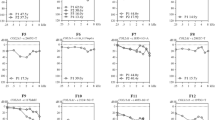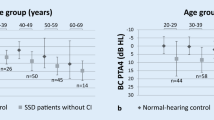Abstract
The objective of this study is to determine whether presbycusis occurs much earlier than previously believed if the high frequency (above 8 kHz) are included. Tertiary referral center (a teaching University). This is a cross-sectional observational study. Healthy adults from 20 to 49 years of age who had essentially normal hearing were included into the study. They were subjected to high frequency pure tone audiometry (until 16 kHz). Participants were grouped based on age ranges of 10 years (e.g., 20–29, 30–39, and 40–49) and the presence of symmetrical high frequency sensor neural hearing loss were documented. There is a significant presence of symmetrical high frequency sensor neural hearing loss (not attributed to any known risk factors) as early as from the age group of 40 to 49 years. Seven of 43 participants (16%) from age group of 20 to 29 years and 12 of 24 participants (50%) from age group of 30 to 39 years had significant high frequency hearing loss. High frequency hearing loss (high frequency Presbycusis) may occur much earlier than previously believed.
Similar content being viewed by others
References
Baraldi Gdos S, de Almeida LC, Borges AC (2007) Hearing loss in aging. Braz J Otorhinolaryngol 73(1):58–64
US National Center for Health Statistics, 2002
Gacek RR, Schuknecht HF (1969) Pathology of presbycusis. Int Audiol. 8:199
Jerger J, Chmiel R, Stach B, Spretnjak M (1993) Gender affects audiometric shape in presbyacusis. J Am Acad Audiol 4(1):42–49
Bredberg G (1968) Cellular pattern and nerve supply of the human organ of corti. Acta Otolaryngol Suppl (Stockh) 236:1–135
Gates GA, Couropmitree NN, Myers RH (1999) Genetic associations in age-related hearing thresholds. Arch Otolaryngol Head Neck Surg 125:654–659
John Cutnell D, Kenneth Johnson W (1998) Physics, 4th edn. Wiley, New York, p 466
Verret DJ, Adelson RT, Defatta RJ (2006) Asymmetric sensorineural hearing loss evaluation with T2 FSE-MRI in a public hospital. Acta Otolaryngologica 126(7):705–707
Suga F, Lindsay JR (1976) Histopathological observations of presbycusis. Ann Otol Rhinol Laryngol 85(2 pt.1):169–184
Nelson E, Hinojosa R (2003) Presbycusis: a human temporal bone study of individuals with flat audiometric patterns of hearing loss using a new method to quantify stria vascularis volume. Laryngoscope 113(10):1672–1686
Nelson EG, Hinojosa R (2006) Presbycusis: a human temporal bone study of individuals with downward sloping audiometric patterns of hearing loss and review of the literature. Laryngoscope 116(9 Pt 3 Suppl 112):1–12
Dai P, Yang W, Jiang S et al (2004) Correlation of cochlear blood supply with mitochondrial DNA common deletion in presbyacusis. Acta Otolaryngol 124(2):130–136
Pickles JO (2004) Mutation in mitochondrial DNA as a cause of presbyacusis. Audiol Neurootol 9(1):23–33
Han W, Han D, Jiang S (2000) Mitochondrial DNA4977 deletions associated with human presbycusis. Zhonghua Er Bi Yan Hou Ke Za Zhi 35(6):416–419
Dai P, Jiang S, Gu R (2000) Cochlear hypoxia and mtDNA deletion: possible correlated factors to cause presbycusis. Zhonghua Yi Xue Za Zhi 80(12):897–900
Author information
Authors and Affiliations
Corresponding author
Rights and permissions
About this article
Cite this article
Arvin, B., Prepageran, N. & Raman, R. “High Frequency Presbycusis”–Is There an Earlier Onset?. Indian J Otolaryngol Head Neck Surg 65 (Suppl 3), 480–484 (2013). https://doi.org/10.1007/s12070-011-0356-x
Received:
Accepted:
Published:
Issue Date:
DOI: https://doi.org/10.1007/s12070-011-0356-x




